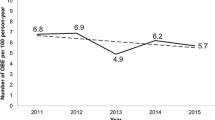Abstract
To assess knowledge and practices of healthcare workers (HCWs) in relation to bloodborne pathogens in a tertiary care hospital, western Saudi Arabia. Self-administered questionnaire was distributed assessing demographic characteristics, knowledge and practices of physicians, nurses and technicians on risks of exposure and prophylaxis against human immunodeficiency virus, hepatitis B virus and hepatitis C virus infections. A total of 466 participants (151; 32.4 % physicians and 315; 67.6 % nurses/technicians) completed the questionnaire. Almost two thirds of the physicians (60.9 %) and half of the nurses/technicians (47.6 %) had history of exposure to risks of bloodborne infection. Although both physicians and nurses/technicians showed acceptable level of knowledge about risks of bloodborne infections, modest proportion knew the correct actions including reporting following exposure. Behavioral-based in-service training interventions and strict policy should be implemented to promote compliance of HCWs to the protective measures against hazards of bloodborne infection.

Similar content being viewed by others
References
US Occupational Safety and Health Administration (OSHA). Infectious diseases. https://www.osha.gov/SLTC/healthcarefacilities/infectious_diseases.html (Accessed 28 Dec 2013).
Kermode, M., Jolley, D., Langkham, B., et al. (2005). Occupational exposure to blood and risk of blood borne virus infection among healthcare workers in rural north India healthcare settings. American Journal of Infection Control, 33, 34–41.
Janjua, N. Z., Razaq, M., Chandir, S., et al. (2007). Poor knowledge–predictor of nonadherence to universal precautions for blood borne pathogens at first level care facilities in Pakistan. BMC Infectious Diseases, 7, 81.
World Health Organization. Selected occupational risks. www.who.int/whr/2002/chapter4/en/index8.html (Accessed 28 Dec 2013).
Pirozzolo, J. J., & LeMay, D. C. (2007). Blood-borne infections. Clinics in Sports Medicine, 26(3), 425–431.
Odoardi, F., Kawakami, N., Klinkert, W. E. F., et al. (2007). Blood-borne soluble protein antigen intensifies T cell activation in autoimmune CNS lesions and exacerbates clinical disease. Proceedings of the National Academy of Sciences of the United States of America, 104(47), 18625–18630.
Hersey, J. C., & Martin, L. S. (1994). Use of infection control guidelines by workers in healthcare facilities to prevent occupational transmission of HBV and HIV: Results from a national survey. Infection Control and Hospital Epidemiology, 15, 243–252.
Clarke, S. P., Rockett, J. L., Sloane, D. M., et al. (2002). Organizational climate, staffing, and safety equipment as predictors of needle stick injuries and near-misses in hospital nurses. American Journal of Infection Control, 30, 207–216.
Aiken, L. H., Sloane, D. M., & Klocinski, J. L. (1997). Hospital nurses’ occupational exposure to blood: Prospective, retrospective and institutional reports. American Journal of Public Health, 87, 103–107.
Beltrami, E. M., Williams, I. T., Shapiro, C. N., et al. (2000). Management of blood-borne infections in healthcare workers. Clinical Microbiology Reviews, 13, 285–307.
Wnuk, A. M. (2003). Occupational exposure to HIV in healthcare workers. Medical Science Monitor, 9, 197–200.
Trim, J. C., & Elliott, T. S. (2003). A review of sharps injuries and preventative strategies. Journal of Hospital Infection, 53, 237–242.
Kim, K. M., Kim, M. A., Chung, Y. S., et al. (2001). Knowledge and performance of the universal precautions by nursing and medical students in Korea. American Journal of Infection Control, 29(5), 295–300.
Patterson, J. M., Novak, C. B., Mackinnon, S. E., et al. (2003). Needle-stick injuries among medical students. American Journal of Infection Control, 31(4), 226–230.
Musharrafieh, U. M., Bizri, A. R., Nassar, N. T., et al. (2008). Healthcare workers’ exposure to blood-borne pathogens in Lebanon. Occupational Medicine (London)., 58(2), 94–98.
Argentero, P. A., Zotti, C. M., Abbona, F., et al. (2007). Regional surveillance of occupational percutaneous and mucocutaneous exposure to blood-borne pathogens in healthcare workers: strategies for prevention. Medicina del Lavoro, 98(2), 145–155.
Moghimi, M., Marashi, S. A., Kabir, A., et al. (2009). Knowledge, attitude, and practice of Iranian surgeons about blood-borne diseases. Journal of Surgical Research, 151(1), 80–84.
Al-Mazrou, Y. Y., Abouzeid, M. S., & Al-Jeffri, M. H. (2005). Knowledge and attitude of paramedical student in Saudi Arabia toward HIV/AIDS. Saudi Medical Journal, 26(8), 1183–1189.
Ertem, M., Dalar, Y., Cevik, U., et al. (2008). Injury or body fluid splash incidence rate during three months period in elective surgery procedures, at Dicle University Hospital, Diyarbakir Turkey. Ulus Travma Acil Cerrahi Derg., 14(1), 40–45.
Moloughney, B. W. (2001). Transmission and post exposure management of blood borne virus infections in the healthcare setting: where are we now? CMAJ, 165, 445–451.
Zafar, A., Aslam, N., Nasir, N., et al. (2008). Knowledge, attitudes and practices of healthcare workers regarding needle stick injuries at a tertiary care hospital in Pakistan. Journal of the Pakistan Medical Association, 58(2), 57–60.
Bilski, B., & Wysocki, J. (2005). The level of knowledge of post-exposure prophylaxis of blood-borne infections at the workplace observed in nurses. Medycyna Pracy, 56(5), 375–378.
Miceli, M., Herrera, F., Temporiti, E., et al. (2005). Adherence to an occupational blood borne pathogens exposure management program among healthcare workers and other groups at risk in Argentina. Brazilian Journal of Infectious Diseases, 9(6), 454–458.
Hesham, R., Tajunisah, M. E., & Ilina, I. (2008). Risk of blood-borne infection among healthcare workers in two Kuala Lumpur hospitals. Medical Journal of Malaysia, 63(3), 222–223.
Sacchi, M., Daglio, M., Feletti, T., et al. (2007). Accidents with risk of blood-borne infections in obstetricians: analysis of a hospital case records. Medicina del Lavoro, 98(1), 64–72.
Gurubacharya, D. L., Mathura, K. C., & Karki, D. B. (2003). Knowledge, attitude and practices among healthcare workers on needle-stick injuries. Kathmandu University Medical Journal, 1(2), 91–94.
Ethical standards
This study has been approved by the research and ethics committee, Armed Forces hospital, Taif, Saudi Arabia and has been performed in accordance with the ethical standards laid down in the 1964 Declaration of Helsinki and its later amendments.
Conflict of interest
The authors declare that they have no conflict of interest.
Author information
Authors and Affiliations
Corresponding author
Rights and permissions
About this article
Cite this article
Al-Zahrani, A.O., Farahat, F. & Zolaly, E.N. Knowledge and Practices of Healthcare Workers in Relation to Bloodborne Pathogens in a Tertiary Care Hospital, Western Saudi Arabia. J Community Health 39, 959–964 (2014). https://doi.org/10.1007/s10900-014-9837-7
Published:
Issue Date:
DOI: https://doi.org/10.1007/s10900-014-9837-7



